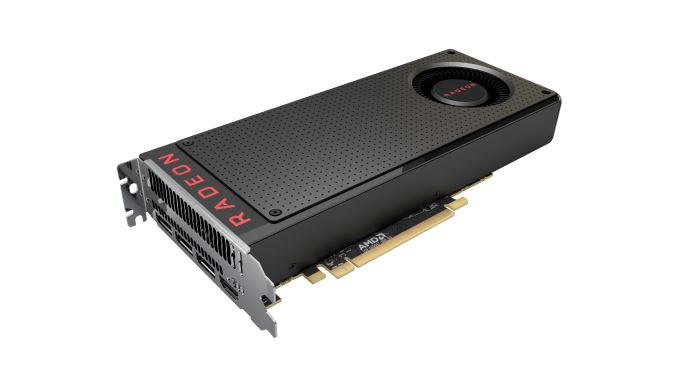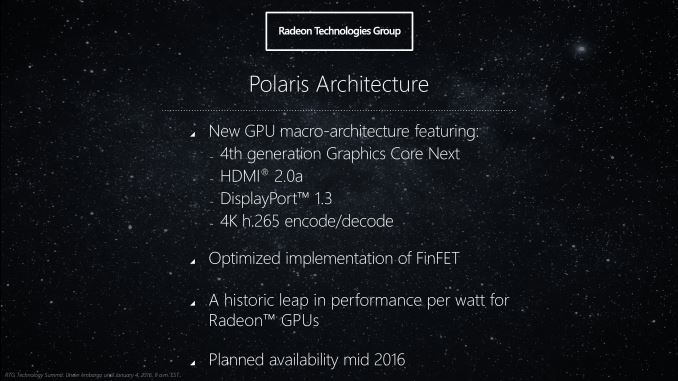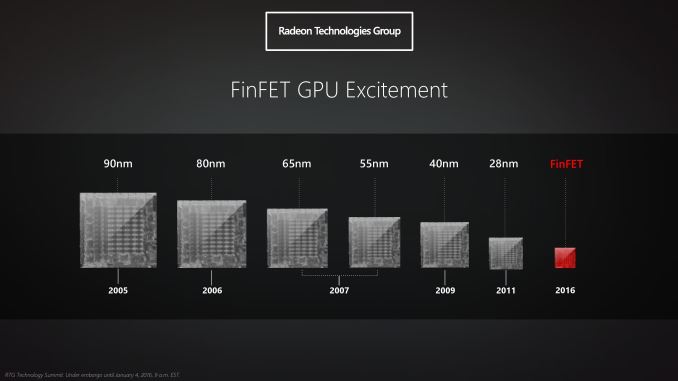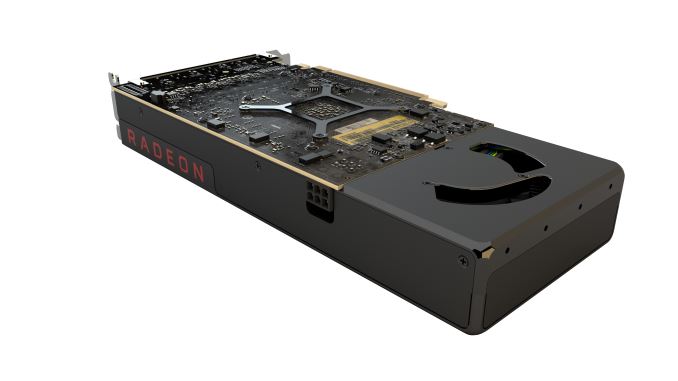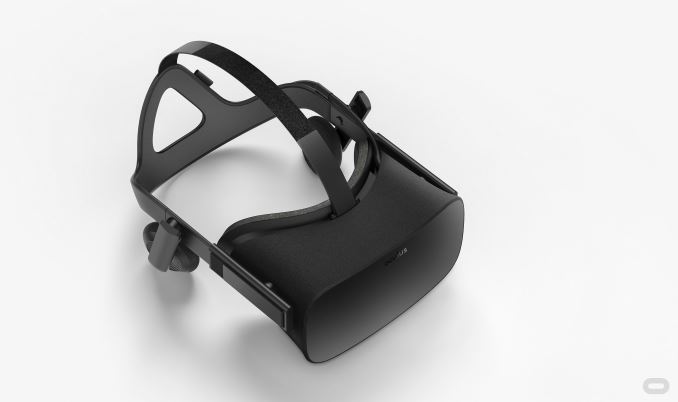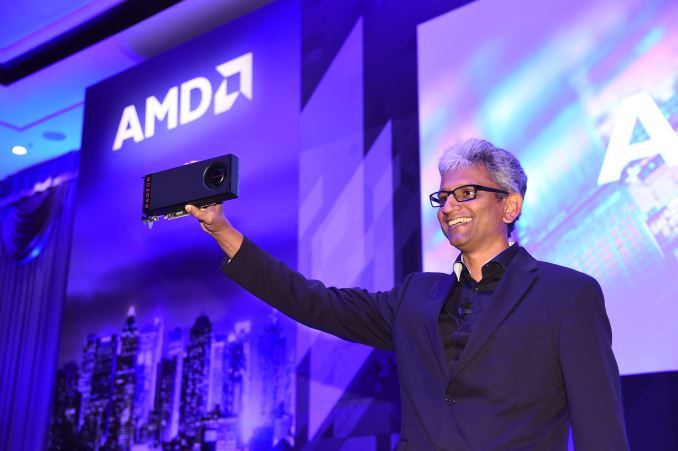
Original Link: https://www.anandtech.com/show/10389/amd-teases-radeon-rx-480-launching-june-29th-for-199
AMD Teases Radeon RX 480: Launching June 29th For $199
by Ryan Smith on May 31, 2016 10:00 PM EST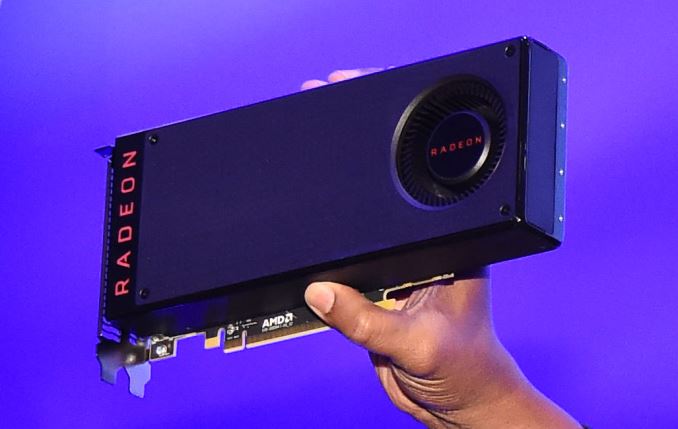
Kicking off at this moment is AMD’s Computex 2016 keynote. The company has multiple announcements scheduled this evening, but we’re going to jump right into an area that has been of extreme interest for many of our readers: GPUs.
Ahead of this evening’s event, AMD sent out an email to the press teasing the first of their discrete Polaris architecture based cards. Called the Radeon RX 480, AMD has unveiled much of the product’s specifications, but also its price and availability. When the card hits the streets on June 29th, it will be starting at the crucial mainstream battleground price point of $199.
| AMD Radeon GPU Specification Comparison | ||||||
| AMD Radeon RX 480 | AMD Radeon R9 390X | AMD Radeon R9 390 | AMD Radeon R9 380 | |||
| Stream Processors | 2304 (36 CUs) |
2816 (44 CUs) |
2560 (40 CUs) |
1792 (28 CUs) |
||
| Texture Units | (Many) | 176 | 160 | 112 | ||
| ROPs | (A Positive Integer) | 64 | 64 | 32 | ||
| TFLOPs (FMA) | >5 TFLOPs | 5.9 TFLOPs | 5.1 TFLOPs | 3.5 TFLOPs | ||
| Boost Clock | >1.08GHz | 1050MHz | 1000MHz | 970MHz | ||
| Memory Clock | 8Gbps GDDR5 | 5Gbps GDDR5 | 5Gbps GDDR5 | 5.5Gbps GDDR5 | ||
| Memory Bus Width | 256-bit | 512-bit | 512-bit | 256-bit | ||
| VRAM | 4GB/8GB | 8GB | 8GB | 2GB | ||
| Transistor Count | ? | 6.2B | 6.2B | 5.0B | ||
| Typical Board Power | 150W | 275W | 275W | 190W | ||
| Manufacturing Process | GloFo 14nm FinFET | TSMC 28nm | TSMC 28nm | TSMC 28nm | ||
| Architecture | GCN 4 | GCN 1.1 | GCN 1.1 | GCN 1.2 | ||
| GPU | Polaris 10? | Hawaii | Hawaii | Tonga | ||
| Launch Date | 06/29/16 | 06/18/15 | 06/18/15 | 06/18/15 | ||
| Launch Price | $199 | $429 | $329 | $199 | ||
First off, the RX 480 will include 36 CUs. If we assume 64 stream processors to a CU – the GCN standard – then this brings us to 2304 SPs. AMD has not named the specific Polaris GPU being used here, but given the CU count I believe it’s reasonable to assume that this is a Polaris 10 SKU, as I’ve already seen Polaris 11 and it’s a very small chip better suited for notebooks.
AMD also revealed that the card would offer over 5 TFLOPs of compute performance. Given what we know about the CU count, this allows us to estimate the GPU clockspeed. This puts the lower bound of the GPU clockspeed at 1.08GHz and an upper bound (6 TFLOPs) at 1.3GHz, which would be in the range of 10-30% higher clocked than comparable Radeon 300 series cards.
In terms of raw numbers this puts the RX 480 just shy of the current Radeon R9 390. However it also doesn’t take into account the fact that one of the major focuses for Polaris will be in improving architectural efficiency. I would certainly expect that even at the lower end of clockspeed estimates, RX 480 could pull ahead of the R9 390, in which case we’re looking at a part that would deliver performance between the R9 390 and R9 390X, with final clockspeeds and architectural efficiency settling just how close to R9 390X the new card gets.
On the memory front the card is equipped with 8Gbps GDDR5, running along a 256-bit memory bus. This is the typical bus width for AMD x80-series cards, and the high clocked 8Gbps GDDR5 means that we’re looking at a total of 256GB/sec of memory bandwidth to feed the RX 480’s GPU. AMD’s partners will be offering both 4GB and 8GB cards, and for the purposes of this teaser I assume that pricing information will be for the 4GB card, with 8GB serving as a premium option.
Finally, AMD has also revealed the TDP for the RX 480, stating that it will be a 150W card. As Polaris is built on 14nm FinFET, we’re seeing first-hand the benefits of finally making the long-awaited jump off of 28nm, as this means we’re looking at Radeon R9 390 series performance in a card that, on paper, consumes only a bit more than half the power. This also puts the RX 480 right in the sweet spot for mainstream cards, as 150W has traditionally struck a good balance between performance and power consumption that allows for a fast card that doesn’t require aggressive cooling, and is more compatible with OEM computer vendor case & cooling designs.
Cementing its place as a mainstream card, the RX 480 pricing will start at $199. This is an aggressive and heavily fought over price point that has traditionally defined the mainstream segment, attracting buyers who want great 1080p gaming performance that sub-$150 value cards can’t offer, without moving up to more expensive (and power hungry) $300+ cards. In this sense the RX 480 is a direct replacement for the R9 380, AMD’s Tonga-based card that hit the market roughly a year ago at the same price. Going by the raw numbers alone, RX 480 would be 40% (or more) faster than the R9 380.
Meanwhile I won’t speculate too much on the competitive market from a teaser, but it’s worth noting that this is nearly half the price of NVIDIA’s currently cheapest Pascal card, the GeForce GTX 1070. Interestingly both cards have the same 150W TDP, but looking at the throughput figures it does not look like RX 480 is meant to offer quite as high performance as NVIDIA’s card.
Moving on, along with teasing the RX 480’s specifications, AMD’s teaser also laid out their marketing plans for the card. We’re previously talked about how both Oculus and Valve/HTC were encouraging developers to treat VR like a fixed platform, and setting minimum hardware specifications to go along with that. On the AMD side those specifications called for a Radeon R9 290, which the RX 480 should be able to beat.
As a result AMD is planning on heavily promoting the VR aspects of the RX 480, as it brings the necessary performance down from a 250W, $300+ card to a 150W, $200 card. In fact AMD is claiming that VR performance will be closer to $500 video cards, in which case we’d be looking at performance closer to the Radeon R9 Nano, a Fiji based card.
With all of that said, the video card is just one component in the total price of a VR system – you still need the headset – but on the PC side it has also been the most expensive component. Consequently, AMD sees cheaper video cards that offer good VR performance as being important to bringing down the total price of a VR-ready system, and will be promoting the RX 480 as the prescription for entry-level VR needs. From a business perspective, AMD is ultimately expecting VR to be a fast-growing market, so the company wants to make sure they don’t miss out and have more VR-capable cards on the market as quickly as they can.
Along those lines, AMD’s release also makes note that at least one model will be “both HTC Vive Ready and Oculus Rift certified,” though no further details are being offered at this time. Whether this is just a certification matter or if there’s going to be something special about this model (e.g. connectors) is open to speculation.
Finally, now that they’ve revealed the price and much of the specifications of their first Polaris card, AMD is also releasing more details on their overall development and market positioning strategy with Polaris. As AMD has hinted at in the past, Polaris is being specifically developed for and aimed at the mainstream market. AMD wants to recapture lost market share – especially in laptops – and the large mainstream market is seen as the best way to do that. AMD is calling this their “water drop” strategy, and I expect we’ll hear a bit more about it tonight, including the meaning behind the name.
And with all of that said, it looks like we’re going to have a lot of AMD to talk about on June 29th. So until they, stay tuned.
Above: AMD SVP & Chief Architect Raja Koduri, Who Is Very Happy That Polaris Is About To Launch
AMD's Full Teaser Text
On June 01, 2016 at 10 a.m. China Standard Time (3 a.m. BST / 4 a.m. CEST) the Radeon Technologies Group will be announcing:
- Radeon™ RX 480 set to drive premium VR experiences into the hands of millions of consumers; priced from just $199
- First Polaris architecture-based graphics processor to deliver VR capability common in $500 GPUs; expected to accelerate the size of the VR-ready install-base and dramatically increase the pace of VR ecosystem growth
- RadeonTM RX 480 specifications including:
| AMD Radeon RX 480 | |
| TFLOPs (FMA) | >5 TFLOPs |
| Compute Units | 36 |
| Memory Bandwidth | 256GB/sec |
| Memory Clock | 8Gbps GDDR5 |
| Memory Bus Width | 256-bit |
| VRAM | 4GB/8GB |
| Typical Board Power | 150W |
| VR Premium | Yes |
| AMD FreeSync | Yes |
| DisplayPort | 1.3/1.4 HDR |
Set to formally launch on June 29th, the Radeon™ RX 480 will deliver the world’s most affordable solution for premium PC VR experiences, including a model that is both HTC™ Vive Ready and Oculus™ Rift™ certified and delivering VR capability common in $500 GPUs.
In a notable market survey, price was a leading barrier to adoption of VR. The $199 SEP for select Radeon™ RX Series GPUs is an integral part of AMD’s strategy to dramatically accelerate VR adoption and unleash the VR software ecosystem. AMD expects that its aggressive pricing will jumpstart the growth of the addressable market for PC VR and accelerate the rate at which VR headsets drop in price:
- More affordable VR-ready desktops and notebooks: AMD expects that affordable PC VR enabled by Polaris architecture-based graphics cards will drive a wide range of VR-ready desktops and notebooks, providing a catalyst for the expansion of the addressable market to an estimated 100 million consumers over the next 10 years.
- Making VR accessible to consumers in retail: Thus far, retail has not been a viable channel for VR sales as average system costs exceeding $999 have precluded VR-ready PCs from seeing substantial shelf space. The Radeon™ RX Series graphics cards will enable OEMs to build ideally priced VR-ready desktops and notebooks well suited for the retail PC market.
- Unleashing VR developers on a larger audience: Adoption of PC VR technologies by mainstream consumers is expected to spur further developer interest across the ecosystem, unleashing new VR applications in education, entertainment, and productivity as developers seek to capitalize on the growing popularity of the medium.
- Reducing the cost of entry to VR: AMD expects that affordable PC VR enabled by Polaris architecture-based graphics cards will dramatically accelerate the pace of the VR ecosystem, driving greater consumer adoption, further developer interest, and increased production of HMDs, ultimately resulting in a lower cost of entry as prices throughout the VR ecosystem decrease over time.
The Radeon™ RX Series launch represents the first salvo in AMD’s new “Water Drop” strategy aimed at releasing new graphics architectures in high volume segments first to support continued market share growth for Radeon™ GPUs. In May 2016, Mercury Research reported that AMD gained 3.2% market share in discrete GPUs in Q1 2016. The Radeon™ RX Series will address a substantial opportunity in PC gaming: more than 13.8 million PC gamers who spend $100-300 to upgrade their graphics cards, and 84% of competitive and AAA PC gamers. With Polaris architecture-based Radeon™ RX Series graphics cards, AMD intends to redefine the gaming experience in its class, introducing dramatically improved performance and efficiency, support for compelling VR experiences, and incredible features never before possible at these prices.
Supporting Quotes:
“VR is the most eagerly anticipated development in immersive computing ever, and is the realization of AMD’s Cinema 2.0 vision that predicted the convergence of cinematic visuals and interactivity back in 2008,” said Raja Koduri, senior vice president and chief architect, Radeon Technologies Group, AMD. “As we look to fully connect and immerse humanity through VR, cost remains the daylight between VR being the purview of the wealthy, and universal access for everyone. The Radeon™ RX Series is the disruptive technology that adds rocket fuel to the VR inflection point, turning it into a technology with transformational relevance to consumers.”
“The Radeon™ RX series efficiency is driven by major architectural improvements and the industry’s first 14nm FinFET process technology for discrete GPUs, and could mark an important inflection point in the growth of virtual reality,” said Patrick Moorhead, principal analyst, Moor Insights & Strategy. “By lowering the cost of ownership and increasing the VR TAM, Radeon RX Series has the potential to propel VR-ready systems into retail in higher volumes, drive new levels of VR content investment, and even drive down the cost of VR headsets.”
“We congratulate AMD for bringing a premium VR ready GPU to market at a $199 price point,” said Dan O’Brien, vice president of virtual reality, HTC. “This shows how partners like AMD survey the entire VR ecosystem to bring an innovative Radeon RX Series product to power high end VR systems like the HTC Vive, to the broadest range of consumers.”

